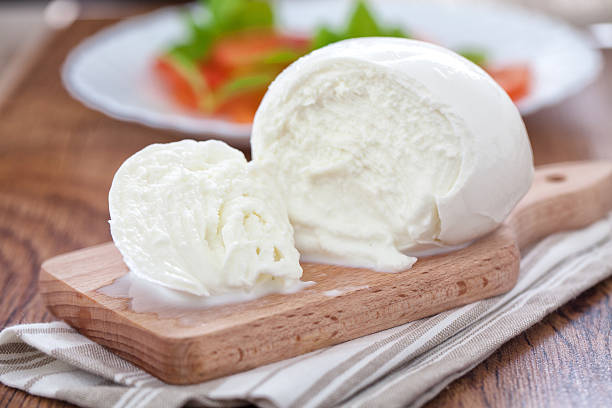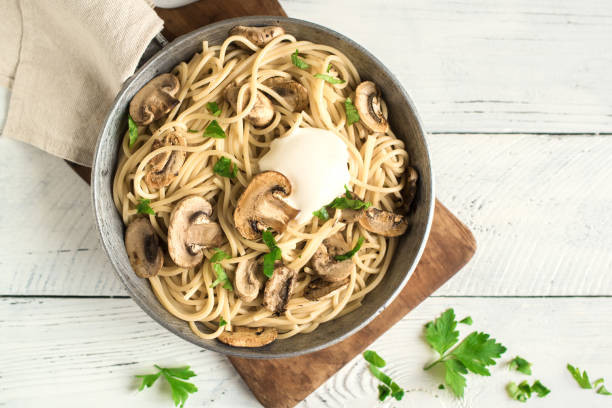Pastrami Vs. Corned Beef: The Main Differences
Pastrami and corned beef are two examples of popular cured meats. Sandwiches, classic meals, and regional cuisines from all over the globe now include these tasty treats. Pastrami and corned beef may have certain similarities, but they also have important distinctions. In this article, we’ll compare and contrast pastrami and corned beef from every angle: the meat used, the seasonings, and the cooking techniques.
Whether you like salty, soft corned beef or smoky, hearty pastrami, learning about the differences between the two will help you appreciate each for what it is. Come along as we explore the differences between pastrami and corned beef and see what makes them such great options.
Cuts of Meat Used for Corned Beef and Pastrami
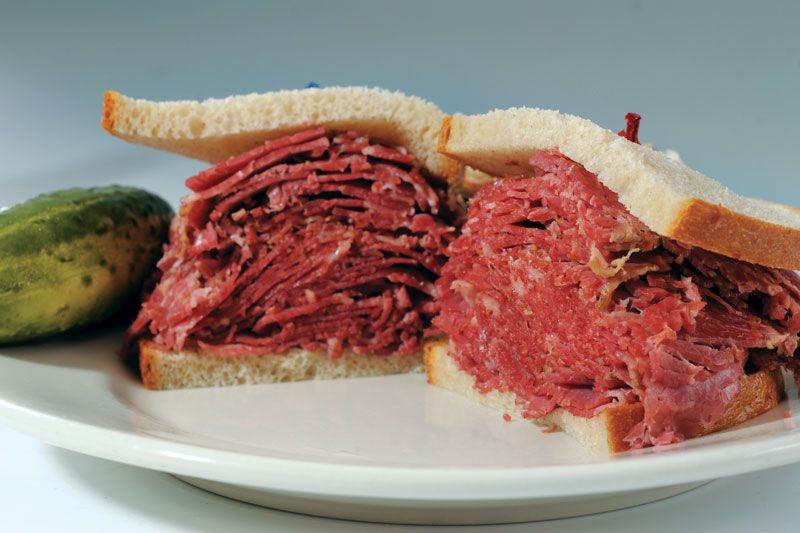
Both corned beef and pastrami are excellent cured meats, yet they have quite different tastes and textures. Differentiating between the two might be as simple as learning about the types of meat utilized.
Corned Beef
Corned beef is made from the brisket, which is the main part of meat utilized. The brisket is cut from the animal’s breast or lower chest. The brining and long cooking enhance the meat’s natural toughness and robust taste.
Corned beef may be made using a limited number of different cuts. However, additional cuts, such as the round (bottom round or eye of round), may be required for some recipes. The final product’s softness and texture may be affected by these little differences.
Pastrami
Similar to corned beef, brisket is the main ingredient of pastrami. Beef navel (also called as plate or belly) is a fatty and marbled cut that may be used to make pastrami that is both rich and tender.
Pastrami’s taste and tenderness may be improved by using a different cut. The most popular cut is brisket because it has the right amount of fat and lean meat for curing, smoking, and slicing.
Brisket is the classic cut for both corned beef and pastrami, although different cuts may be used in regional or artisanal versions. As a result, meat connoisseurs have a wide variety of alternatives to try out, each with its own unique taste and texture.
Processing Method for Corned Beef and Pastrami
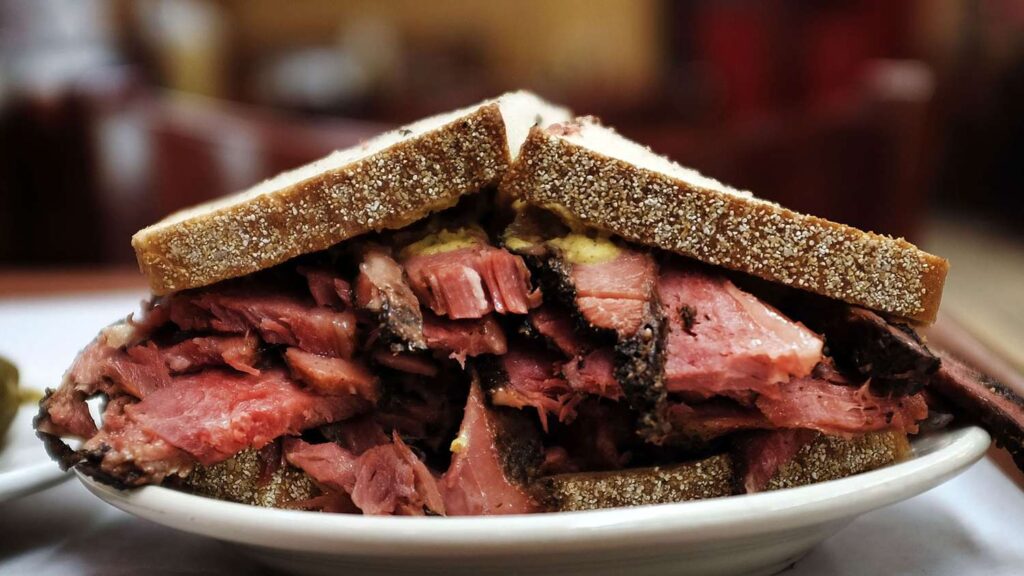
Different preparation processes give corned beef and pastrami their distinctive tastes and textures.
Corned Beef
The process of making corned beef involves brining the meat. Here’s a breakdown of the steps:
Brining: The brisket is submerged in a brine solution, typically consisting of water, kosher salt, curing salts (containing sodium nitrate or nitrite), and various spices and flavorings like garlic, peppercorns, and bay leaves. The brine penetrates the meat, enhancing its flavor and preserving it.
Curing: The brisket is left in the brine for several days, allowing the salts and spices to work their magic. The curing process tenderizes the meat and imparts the characteristic tanginess associated with corned beef.
Pastrami
Similar to corned beef in that it’s created from a smoked and spice-rubbed chunk of meat, pastrami begins with brisket.
Brining: Like corned beef, the first step in making pastrami is to brine the brisket in a solution of water, salt, curing salts, and spices. The meat is preserved and infused with taste via the brining procedure.
Drying: Once the brisket has been brined, it is taken out of the brine, washed, and then dried. During the smoking process, the pellicle (a thin, sticky covering on the surface of the meat) helps absorb smoke.
Smoking: Hickory or oak hardwoods are often used for the traditional low-heat smoking method used to create pastrami. The smoking procedure not only adds taste but also makes the meat more soft.
Spice Rub: Once the pastrami has been smoked, it is covered with a spice rub that commonly includes cracked black pepper, coriander seeds, mustard seeds, and other spices. The spice rub helps give pastrami its robust and nuanced taste.
The curing and smoking processes might vary from one person to the next or from one place to the next. Different seasonings or modifications to the brining and smoking times may be called for in various recipes. Additionally, liquid smoke or oven-roasting may be used in place of conventional smoking in contemporary techniques.
Nutritional Profile of Corned Beef and Pastrami
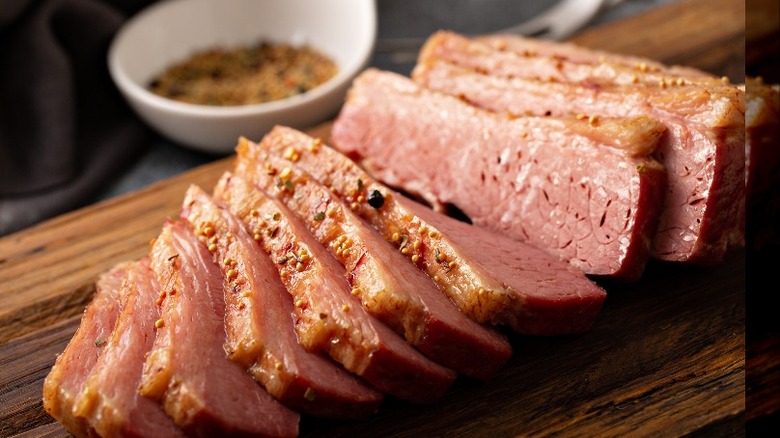
The nutritional profiles of corned beef and pastrami are comparable since they both start with cattle. However, the nutritional value of these foods might be affected by the processing methods used.
Calories
Due to its high meat content, both corned beef and pastrami are heavy in calories. A 3-ounce (85-gram) portion of corned beef or pastrami, on average, provides around 210-250 calories.
Fat
There may be some fat in corned beef and pastrami. The marbling and discernible fat content of the meat utilized is the primary factor in determining the total amount of fat in the dish. Corned beef and pastrami, in a 3-ounce portion, generally include between 15 and 20 grams of fat.
Protein
Corned beef and pastrami are both high-quality protein foods. About 20-25 grams of protein may be found in a 3-ounce portion, making it an excellent choice for muscle development and maintenance.
Sodium
The amount of sodium in a food is a major factor, particularly for those trying to limit their salt consumption. The brining process causes certain processed meats, such corned beef and pastrami, to have excessive levels of salt.
Corned beef and pastrami, typically served in 3-ounce portions, may have between 800 and 1,200 mg of salt per serving. It’s worth noting that low-sodium alternatives exist, or that the brining procedure may be modified to get desired results at home.
The impact of different processing techniques on the nutritional profiles is worth considering:
Brining: Both corned beef and pastrami benefit from brining, which enhances their taste and helps them last longer. The finished product has a higher salt content due to the brining procedure. The salt concentration may be lowered by adjusting the brining time or by using low-sodium ingredients.
Smoking and Spice Rub: Pastrami’s extra steps of smoking and the spice rub coating do not drastically alter the meat’s nutritional profile. However, depending on the precise components used, the spice rub may bring new tastes and maybe minor quantities of extra calories, salt, or other nutrients.
If you’re limiting your calorie, fat, or salt consumption, eating corned beef and pastrami in moderation is a good idea. Meals centered on these meats may be made more nutritious by include a wide range of vegetables, healthy grains, and other nutrient-rich foods.
Flavor Profile of Corned Beef and Pastrami

The unique flavors of corned beef and pastrami are what make these cured meats so popular. Let’s go into the specifics of each and see how they stack up against one another.
Corned Beef
Corned beef has a characteristic flavor that may be identified by its
Saltiness: The brining process adds a delightful saltiness to the meat, which contributes to corned beef’s signature flavor. The meat’s taste is improved and it is preserved by the curing salts in the brine.
Subtle Spice Notes: Corned beef often has hints of spice to complement its saltiness. Peppercorns, coriander seeds, mustard seeds, and bay leaves are just a few examples of the traditional spices used in cooking. The flavor is improved by the use of these spices.
Pastrami
The distinctive taste profile of pastrami is one among the things that sets it apart.
Smokiness: Pastrami has a distinct smokiness that sets it apart from other types of meat. Traditional hardwood smoking imparts a delicious smokiness, increasing the meat’s depth of flavor.
Complexity of Spice Rub: Pastrami’s taste profile is elevated by the complexity of a strong spice rub. Pastrami gets its distinctive flavor from a rub made of crushed black pepper, coriander seeds, and mustard seeds. Layers of flavor, from earthy and peppery to somewhat acidic and fragrant, are imparted by the spice rub.
Serving Style of Corned Beef and Pastrami
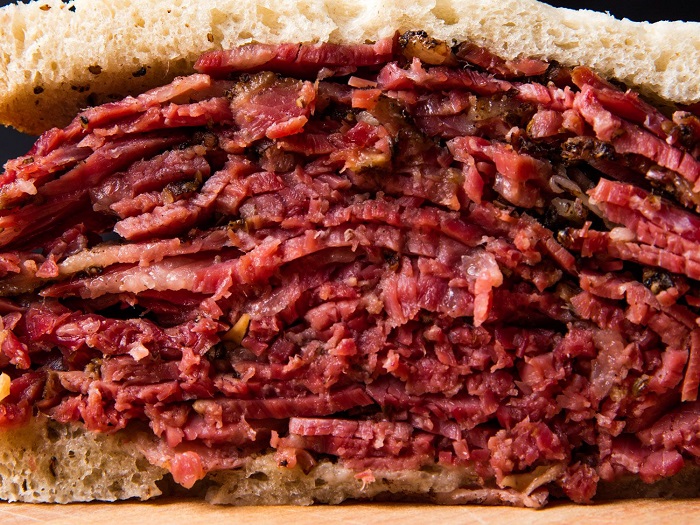
Corned Beef
Traditional serving styles for corned beef include:
Boiled or Braised: Corned beef is often boiled or braised to achieve tenderness. It is commonly cooked with aromatic vegetables like onions, carrots, and celery to enhance the flavor. The resulting broth is used as a flavorful base for serving.
Pairings: Classic side dishes that go well with corned beef include cabbage, potatoes, and carrots. The veggies soak up the liquid taste while cooking with the meat.
Regional or cultural variations: Corned beef and cabbage are traditional St. Patrick’s Day fare in Irish-American households. It’s important to note, however, that in Ireland, cabbage is often served with bacon or salted pork.
Pastrami
The typical serving style for pastrami is:
Thinly Sliced in Sandwiches: Pastrami is most often used in deli-style sandwiches, where it is thinly sliced and given a prominent role. On rye bread or rolls, it is sliced thinly and stacked high. The acidic and salty mix of mustard and pickles is a common addition.
Regional or cultural variations: New York’s pastrami sandwich, made with rye bread and mustard, is a classic example of a cultural variety. Pastrami sandwiches, however, may take on a variety of forms depending on the location or culture that is making them.
Conclusion
In conclusion, although both corned beef and pastrami start with beef and go through curing procedures, they are otherwise very different in terms of taste, texture, and preparation.
When you know the distinctions between corned beef and pastrami, you can better appreciate the history, tradition, and taste of these two classic cured meats. Each and every mouthful of a delicious pastrami sandwich or a platter of corned beef and cabbage is an unforgettable experience.
Whether you like the saltiness and subtle spice notes of corned beef or the smokiness and nuanced tastes of pastrami, it’s clear that both of these cured meats have earned their place in culinary history and remain popular among meat lovers everywhere.


